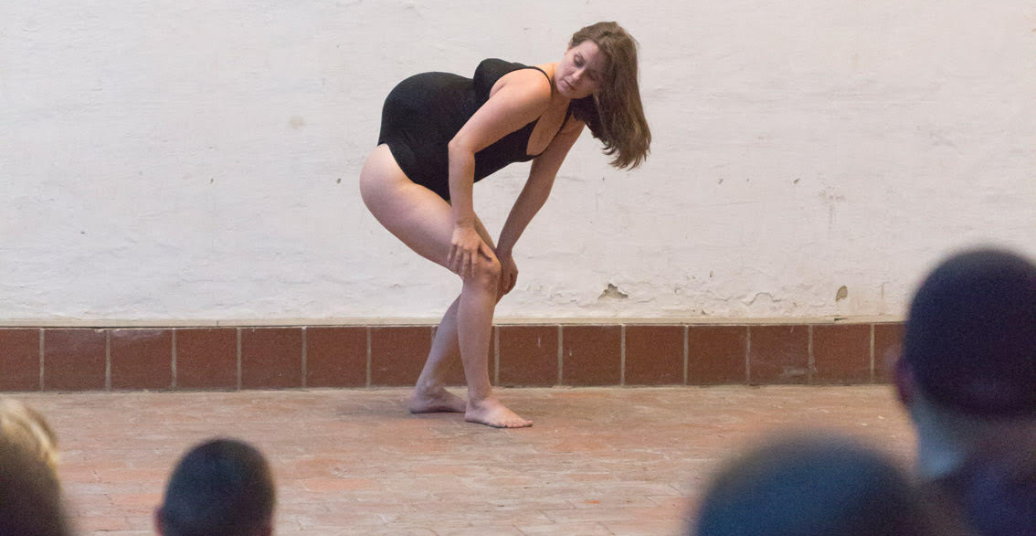Sonya Levin’s PASTPARTUM on 7 September at Kleine Orangerie explores pregnancy to ask how we constantly consume and are consumed by our own production in cycles of self-reconstruction.
A body lies flat on the brown brick floor: bare legs, hair strewn across a faceless head and a late-stage pregnant belly and breasts mounted on her back, stretching the fabric of a black leotard. I see her lying on her front, soles of feet upward, and refocus to see her lying face up with her (back)belly rising and falling with breath: life.
A disembodied hand feels across this landscape, recalling ‘Thing’ from The Addams Family, up her leg, cupping mounds of belly and breasts, across the pelvis to stroke either genitals or buttocks, depending on my perception.
Performed the day after prolific artist Rebecca Horn—known for body modifications through padded extensions and prosthetic bandages—passed away, Levin continues lineages of artistic explorations of the human body represented through abstraction to play with how a viewer perceives form, to question experiences of time through life.
She rigorously pushes this visual study, as her body, ‘facing’ the back wall, presents the prosthetics on her back as her ‘front’. She subtly contorts, ‘frontally’ addressing this female figure in the forward-moving process toward birth-giving at her back. A woman’s voice sounds words and phrases here and there (“memory”), and I wonder if this is a live or recorded utterance. Eventually, her body rotates, revealing the second ‘front’ of her morphing figure, and she engages in dialogue with her pre-recorded voice. In self-interview, the live self reflects and speculates with the recorded self about identity, DNA, personal and political history, nostalgia and revolution, carrying the bodily protrusions on her back like a rucksack. She continues sculpting new shapes, now and then standing profile on one leg and turning her face to us, one hand gathering her hair atop her head, referencing abstract expressionist figures depicted in Egon Schiele’s paintings, also self-portraiture.
Levin’s minimalist, personal solo is in sophisticated conversation with artists who have used their bodies to question self- and motherhood. I recall Xavier Le Roy’s perpetually transforming Self-Unfinished, Mette Ingvarten’s Manual Focus (flipping ‘faces’ and ‘backs’), and Self-Portrait on the sixth wedding anniversary by Paula Modersohn-Becker who painted herself pregnant before she became so. Colourful, blurred paintings by Camille Henrot and Bracha Ettinger (who theorised the ‘matrixial’ realm as a shareable, psychic dimension of emergence across thresholds of identity and memory), in visual contrast to the black-and-white physical abstractions of Levin’s form, also conjure imaginaries inside the transformative process of natal experience and the continuity of a person through the many selves of a life.
The relationship between the image of Levin’s distorting body and her thinking conversation raises questions about what bodies carry: dance histories, generational experience, culture, the onward marching nature of time and the inevitable transformation and loss of the past. Nostalgia is called a “resistance to loss”, and I reflect on the cyclical temporality of birth, death, memory and pain and philosopher Rosi Braidotti’s affirmative ethics toward interconnected ‘intra-action’ in lieu of nostalgia and revolution. We co-emerge through our bodies; the womb as a matrix of relationality.
PASTPARTUM, by Sonya Levin was performed on 7 September 2024 at Kleine Orangerie.




